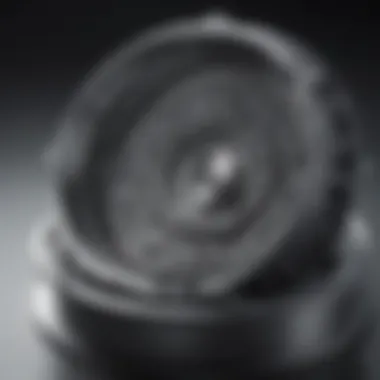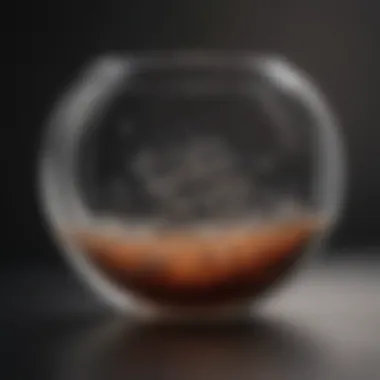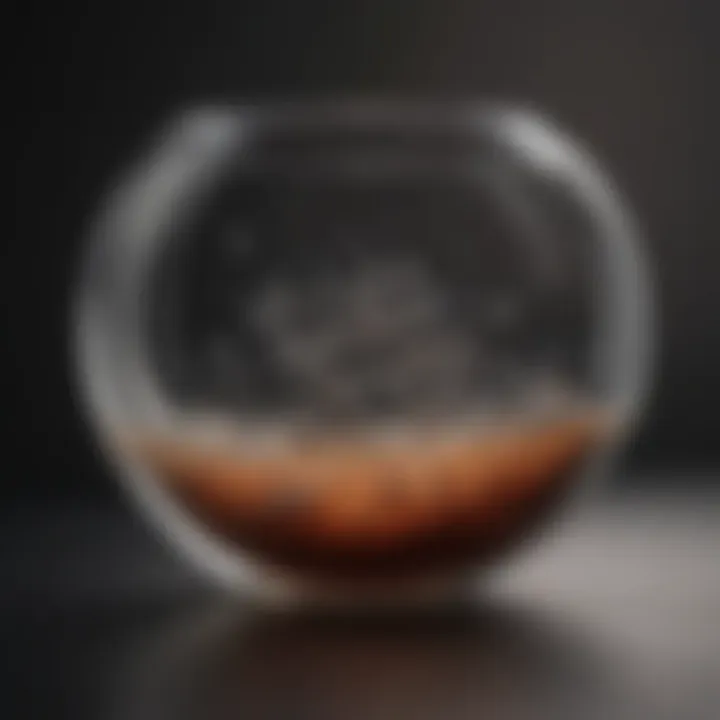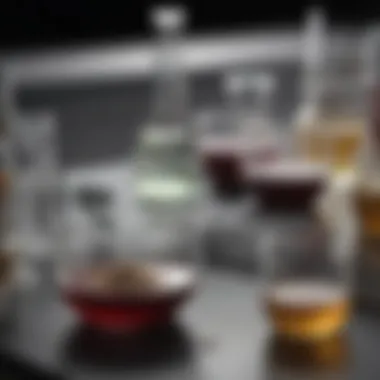Sieving Chemistry: Principles and Advances in Science


Intro
Sieving chemistry serves as a fundamental aspect of numerous scientific fields, underpinning the methods used to separate and classify materials. This intricate discipline marries the principles of physical chemistry with practical applications, providing tools for a vast array of industries. From pharmaceuticals to environmental science, sieve processes are crucial in achieving purity and quality in products.
In this article, we will not only explore the core principles of sieving chemistry but also examine its practical applications and recent advancements. By highlighting these key components, we aim to provide a comprehensive understanding suitable for students, researchers, educators, and professionals.
Within the realm of sieving chemistry, one can find the intersection of theory and practice, demonstrating its relevance across multiple disciplines. The methods utilized in sieving are not just limited to basic filtering; they encompass sophisticated techniques that adapt to the demands of modern science and technology.
Understanding this topic can enhance one’s appreciation for the precision required in material selection and the importance of achieving desired outcomes in both academic and industrial settings.
As we progress through the article, expect to uncover insights about both traditional and modern sieving techniques, assess their efficacy in varying contexts, and recognize the continual evolution in this field.
Overview of Sieving Chemistry
Sieving chemistry plays an integral role in a variety of scientific disciplines, influencing how materials are processed and classified. The fundamental importance of this topic lies in its ability to facilitate the separation of particles based on size, shape, and density. Understanding sieving chemistry is crucial for professionals working in several fields, ranging from environmental science to pharmaceuticals. The insights gained from sieving processes contribute to sustainability practices as well.
For researchers and educators, sieving chemistry represents a foundational concept that bridges theoretical knowledge with practical applications. The various techniques associated with sieving are essential for the advancement of materials engineering and the creation of new technologies.
Benefits of Sieving Chemistry
- Efficiency: Precise particle separation enhances processing efficiency in numerous industries.
- Quality Control: Ensures the quality of materials and products, particularly in pharmaceuticals and construction.
- Environmental Impact: Contributes to pollution monitoring and waste management through effective material separation.
Overall, this section sets the stage for a deeper exploration of the principles, methodologies, and advances that shape the evolving landscape of sieving chemistry.
Defining Sieving Chemistry
Sieving chemistry involves the process of separating particles in a mixture based on their physical characteristics. This process is guided mainly by the principles of particle size and density. Sieving techniques can be applied to both solid and liquid samples, offering a versatile approach to material classification.
In practical terms, sieving might involve the use of a mesh or sieve that allows smaller particles to pass through while retaining larger ones. The size of the openings in the sieve determines the level of separation achieved. Thus, the design of a sieving system must consider the specific requirements of the task at hand.
Key Components of Sieving Chemistry:
- Particle Size: The most critical factor in sieving processes, affecting both the efficiency and outcome.
- Flow Dynamics: Understanding how particles move through media is essential for optimizing sieving operations.
Historical Context
The roots of sieving chemistry can be traced back to ancient civilizations, where simple mechanical methods were employed for grain separation. Over the centuries, advancements in technology have significantly refined these methods, leading to more precise techniques that employ both manual and automated systems.
The evolution of sieving practices has paralleled advances in material science, with notable improvements in equipment and techniques. Initially, sieving was limited to basic mesh screens, but the introduction of vibration and air flow techniques has revolutionized the efficiency and capability of sieving processes.
“As technology evolved, so did our understanding of particle behavior, leading to more sophisticated sieving methods.”
“As technology evolved, so did our understanding of particle behavior, leading to more sophisticated sieving methods.”
In modern contexts, sieving chemistry is closely related to fields like nanotechnology, where the separation of nanoparticles is of paramount importance. This historical perspective highlights not only the significance of sieving chemistry in today’s applications but also the continuous quest for improvements in methodology and technology.
Fundamental Principles
Understanding the fundamental principles of sieving chemistry is essential to grasp the underlying mechanisms that govern the separation of particles. These principles provide the foundation on which various sieving techniques and applications are built. By focusing on specific elements such as particle size distribution, density, and shape factor considerations, the field can evolve, leading to improved methodologies in material classification and separation processes.
The significance of these fundamental principles lies in their direct impact on the efficiency and effectiveness of sieving. Enhanced knowledge about these principles informs researchers and practitioners, enabling them to choose the most appropriate techniques for their specific needs. Furthermore, as advancements in technologies emerge, a solid understanding of these principles helps in optimizing sieving processes, resulting in better outcomes across various disciplines.
Particle Size Distribution
Particle size distribution is a critical aspect of sieving chemistry. It refers to the range of sizes of particles within a material and is often expressed as a percentage of the total mass. Achieving a thorough understanding of particle size distribution allows scientists to determine the suitability of a material for specific applications. For example:


- In pharmaceutical development, the particle size can influence drug bioavailability.
- In materials engineering, uniform particle sizes can improve the stability and performance of composite materials.
Key factors affecting particle size distribution include the method of material production and the environments in which they are processed. Various analytical techniques, such as laser diffraction and dynamic light scattering, are employed to assess size distributions accurately. Having precise data on particle sizes enhances the sieving process, leading to more efficient separation and better quality control in final products.
Density and Its Role
Density plays a vital role in sieving chemistry. It is defined as the mass per unit volume of a material and helps in distinguishing particles. Density variations among particles can significantly influence their behavior during sieving. For example, different materials may be subjected to the same sieving conditions but achieve different separation outcomes due to their varying densities.
In practical applications, density measurements can guide the selection of sieving equipment and conditions. Understanding density aids in determining whether a material will sink or float when mixed with another substance, thereby optimizing separation techniques. Density can also be leveraged in designing layered sieves that exploit gravitational forces to achieve efficient classification of materials.
Shape Factor Considerations
The shape factor refers to the geometric configuration of particles and is crucial in sieving chemistry. Unlike size and density, shape affects how particles interact with one another and with the sieve medium during the separation process. Irregularly shaped particles may tend to clog sieves more easily than spherical ones, which could hinder efficient sieving.
Consideration of shape allows researchers to tailor sieving strategies to accommodate for the particle morphology. Some particles may require specialized sieves or processing techniques, particularly in industries that demand high precision, such as pharmaceuticals and nanomaterials development. The shape factor can also affect flowability and packing density, both of which are important in material handling and processing.
A thorough understanding of the shape factor can lead to innovations in sieving technology, enhancing operational efficiency.
A thorough understanding of the shape factor can lead to innovations in sieving technology, enhancing operational efficiency.
In summary, the fundamental principles of sieving chemistry serve as a guide for practitioners to understand how the essential characteristics of particles play a role in separation processes. Recognizing the interplay between particle size, density, and shape not only improves existing techniques but also paves the way for future innovations in various domains.
Sieving Techniques
Sieving techniques are essential in the field of sieving chemistry, as they play a crucial role in the separation and classification of materials. Numerous applications depend upon the effectiveness of these techniques, which range from traditional methods to sophisticated modern instrumentation. Understanding these techniques allows researchers and professionals to optimize processes across various industries.
Classical Sieving Methods
Classical sieving methods are rooted in established practices that have been utilized for centuries. These methods primarily involve the use of porous materials, often referred to as sieves, to separate particles based on size. Commonly used sieving devices include woven mesh screens and perforated plates. The effectiveness of classical methods can vary based on channel design, sieve material, and vibration techniques applied.
Advantages:
- Simplicity: Classical methods are easy to use with minimal training required.
- Cost-effectiveness: Typically less expensive compared to modern techniques, making them accessible for small-scale operations.
However, these methods also present limitations. They often lack precision in size separation. Factors such as moisture content and particle shape can influence their efficiency. As a result, classical sieving methods are usually most effective in applications where high precision is not a critical requirement.
Modern Instrumentation
Modern instrumentation has revolutionized the domain of sieving techniques. With advancements in technology, new devices such as laser diffraction and air jet sieving systems offer enhanced accuracy and efficiency. Laser diffraction, for instance, analyzes the scattering patterns of light passing through particles, allowing for rapid and precise measurement of particle size distribution.
Benefits of modern instrumentation:
- Higher accuracy: Enhanced capability to measure particle sizes within narrow ranges.
- Automation: Reduces the need for manual intervention, leading to time savings and less human error.
- Data analysis: Sophisticated software often accompanies modern devices, offering comprehensive analysis and reporting features.
Modern methods address some limitations inherent in classical techniques, making them more suitable for applications that require high precision, such as pharmaceutical development and nanomaterials research.
Comparative Analysis of Techniques
Analyzing classical and modern sieving techniques illustrates the evolution and adaptability of sieving methods. While classical techniques remain relevant, especially in less demanding applications, modern instrumentation is increasingly preferred in scenarios requiring stringent control over particle sizes.
- Precision vs. Accessibility: Modern devices provide unmatched precision but come at higher costs. Classic methods, while more affordable, may not meet the needs for high precision.
- Scalability: Modern techniques offer scalability, suitable for both small labs and large production facilities, while classical methods may be limited by manual processing constraints.
- Flexibility of Use: Some traditional techniques can adapt well to various materials, whereas modern systems may require specific conditions for optimal performance.
In summary, the choice between classical and modern sieving techniques depends on the specific requirements of the application. A thoughtful selection can lead to significant improvements in productivity and outcomes.
Applications of Sieving Chemistry
The applications of sieving chemistry are diverse and crucial across various scientific fields. They provide effective solutions for particle separation and classification, enhancing both research and practical applications. This section delves into specific areas, examining how sieving chemistry contributes to significant advancements in environmental science, materials engineering, and the pharmaceutical industry.


Environmental Science
Pollution Control
Pollution control is one of the most pressing challenges today. Sieving chemistry plays a pivotal role in developing effective methods for separating pollutants from natural resources. One key characteristic of pollution control via sieving involves the ability to target specific particle sizes. This capability allows for the removal of contaminants such as heavy metals or microplastics from water and soil, which is vital for restoring ecological balance. The choice of sieving techniques in this context is beneficial due to their efficiency and low operational costs.
A unique feature of pollution control is the application of advanced sieving materials, such as membranes and filters, that offer enhanced selectivity. These innovations consistently show advantages, including reduced energy costs and minimal chemical usage, which align with the goals of sustainable practices in environmental management. However, challenges remain, such as the durability of sieving materials over extended use.
Waste Management
In waste management, sieving chemistry is essential for sorting and recycling materials effectively. This technique enables the segregation of different waste streams, which helps reduce landfill usage and enhances resource recovery. An important aspect of waste management is the grading of waste materials by size, ensuring that recyclable materials are extracted efficiently.
The key characteristic that makes sieving a popular choice in waste management is its adaptability to different types of waste, including organic and inorganic materials. Its unique aspect lies in its capacity to streamline processes in recycling facilities, often leading to improved operational efficiency. Nevertheless, the method can have disadvantages, such as the need for pre-treatment of waste to remove larger items that can damage sieving equipment.
Materials Engineering
Nanomaterials Development
The field of nanomaterials development greatly benefits from sieving chemistry. This aspect involves precise sizing and separation of nanoparticles, which are critical for their unique properties and applications. The capability to obtain high purity levels of nanomaterials largely stems from effective sieving processes. This ensures consistency in size and morphology, which can significantly influence the performance of materials in various applications, including electronics and medicine.
A key feature is the utilization of specialized equipment that can achieve nanoscale sieving. Such technologies allow researchers to develop materials with tailored properties. While the benefits include enhanced functionality, challenges exist in maintaining the stability and handling of nanoscale particles during sorting.
Composite Materials
Composite materials are integral to modern engineering applications, blending two or more constituent materials to achieve desired properties. The role of sieving chemistry in this context lies in its ability to ensure uniformity in particle size distribution within the composite matrix. This aspect is crucial for the performance and mechanical strength of the final product.
The main characteristic that makes sieving optimal for composite materials is its ability to influence the physical and chemical interactions of the components. The unique feature here includes the ability to produce materials with enhanced properties such as improved durability or strength-to-weight ratio. However, the complexity of synergistic effects from mixed materials can sometimes complicate the process, requiring careful consideration in design and execution.
Pharmaceutical Industry
Drug Formulation
In the pharmaceutical industry, sieving chemistry is vital for drug formulation processes. The goal is to create medicines that have an appropriate particle size for optimal dissolution and absorption in the body. This involves the careful selection of sieving methods to ensure the correct sizing of active pharmaceutical ingredients (APIs) and excipients.
A primary characteristic of drug formulation through sieving is the ability to achieve reproducibility in dosages. The unique features of these methods improve the consistency and quality of pharmaceutical products. However, challenges arise in the scaling of these processes from experimental to industrial levels while maintaining efficiency and compliance with regulatory standards.
Quality Control
Quality control in pharmaceutical production relies heavily on sieving to ensure that the final products meet stringent quality criteria. Effective sieving allows manufacturers to check for uniformity and prevent contamination of product batches. This is especially important for ensuring that products are safe and effective for consumer use.
The key characteristic of quality control via sieving is its ability to provide rapid feedback during the manufacturing process, allowing for prompt adjustments. A unique feature of this application is the incorporation of advanced analytical techniques that run parallel to sieving processes, thus enhancing overall efficiency. Nonetheless, the varying nature of raw materials can introduce variables that affect sieving outcomes, necessitating continuous monitoring.
"One can often understand material behavior by simply looking at the particle size distribution. Sieving offers a straightforward but powerful approach to analyze and optimize material properties across different applications."
"One can often understand material behavior by simply looking at the particle size distribution. Sieving offers a straightforward but powerful approach to analyze and optimize material properties across different applications."
Recent Advances in Sieving Chemistry
Recent advances in sieving chemistry represent a significant evolution in the methods by which materials are separated and categorized. Modern challenges require innovative approaches that streamline processes, enhance precision, and improve efficiency. The integration of new technologies into traditional sieving techniques opens possibilities for applications that extend beyond classic boundaries. Given the growing complexity of materials, understanding these advancements is crucial for researchers, educators, and industry professionals alike. The enhancement in separation accuracy not only benefits scientific research but also has profound implications in industrial settings.
Nanotechnology Impacts
Nanotechnology has reshaped the landscape of sieving chemistry in various ways. At the nanoscale, the properties of materials can differ drastically from their bulk counterparts. The ability to manipulate materials at this level allows for finely-tuned sieving processes. One of the major impacts is the development of nano-sieves, which can selectively separate particles based on size and shape with exceptional precision. These advancements lead to improvements in areas ranging from pharmaceuticals to environmental remediation.
- Size Selectivity: The small pore size of nano-sieves allows only certain molecules to pass, facilitating the separation of contaminants from desired substances.
- Enhanced Surface Area: Nano-sized particles often have increased surface area, which enhances interaction with other compounds, thereby improving separation efficacy.
- Functionalization Opportunities: Nanomaterials can be engineered to possess specific chemical functionalities, enabling targeted sieving applications.


This tailored approach to sieving, driven by nanotechnology, not only optimizes existing practices but also introduces new avenues for research and application.
Innovative Separation Processes
The landscape of sieving chemistry has been transformed by innovative separation processes that address existing challenges more effectively. Recent techniques focus on increasing separation efficiency while minimizing resource use. Two noteworthy avenues in this domain are magnetic sieving and membrane filtration technologies.
Magnetic sieving utilizes magnetic particles to improve separation efficiency. This approach enhances the ability to separate ferromagnetic materials from non-magnetic ones, thereby streamlining processes in recycling and waste management.
Membrane filtration has also gained traction as it allows for selective separation based on membrane properties. This method is particularly useful in water purification and desalination, presenting a sustainable solution in resource management.
The future of sieving chemistry hinges on the adoption of these innovative methods that prioritize efficiency and sustainability.
The future of sieving chemistry hinges on the adoption of these innovative methods that prioritize efficiency and sustainability.
By integrating these recent advancements, researchers and practitioners are better equipped to face challenges across various fields, making sieving chemistry not only a study of particles but also a vital tool for innovation.
Challenges in Sieving Chemistry
Sieving chemistry faces several challenges that impact its efficacy and application across various scientific fields. Understanding these challenges is essential for advancing methodologies and developing innovative solutions. The limitations of current techniques often lead to inefficiencies in material separation and classification. Moreover, identifying research gaps can inspire new studies that ultimately enhance sieving practices. These considerations are crucial as they directly influence the future of sieving chemistry and its relevance in various disciplines.
Limitations of Current Techniques
Despite advancements in sieving techniques, practical limitations are evident. Some of the primary concerns include:
- Size Range Limitations: Many traditional sieving methods have difficulty effectively separating particles within specific size ranges. This often results in inadequate separation of materials, particularly in nanotechnology applications where precise differentiations are required.
- Clogging and Adherence Issues: In wet sieving processes, particles can clump together or stick to the sieve mesh, leading to inaccurate separation outcomes.
- Sensitivity to Environmental Factors: External variables such as humidity and temperature can impact the performance of sieving apparatus, thereby affecting the quality of results.
Additionally, the precision of current techniques can be compromised by factors such as particle shape and density variations, which influence flow dynamics. While modern instrumentation aims to overcome these issues, the effectiveness varies significantly with the nature of the material being processed.
Research Gaps
Identifying research gaps is another key aspect of navigating the challenges in sieving chemistry. While existing literature extensively covers various sieving techniques, several areas require more in-depth investigation:
- Innovative Material Development: There is a need for research into new materials used in sieve construction that can minimize clogging and enhance separation processes.
- Integration of Advanced Technologies: Studies focused on integrating artificial intelligence and machine learning in sieving processes could vastly improve accuracy and efficiency. Current work on applying these technologies is limited.
- Environmental and Sustainable Practices: As environmental concerns grow, research into sustainable sieving processes that minimize waste and energy consumption is becoming increasingly important. However, there is still much to explore in this domain.
- Interdisciplinary Approaches: The potential for interdisciplinary collaboration between fields like chemistry, engineering, and environmental science is not fully realized. Bridging these gaps can yield innovative solutions to existing challenges.
"Addressing these challenges in sieving chemistry is not just about improving techniques; it's a pathway toward sustainable and efficient practices that can impact multiple industries."
"Addressing these challenges in sieving chemistry is not just about improving techniques; it's a pathway toward sustainable and efficient practices that can impact multiple industries."
By targeting these limitations and knowledge voids, future research can offer significant enhancements to sieving chemistry's role in varied applications. The success in overcoming these challenges ultimately preserves the relevance and efficacy of sieving methodologies in modern science.
Future Directions in Sieving Research
The area of sieving chemistry is evolving rapidly. Future research directions are crucial for advancing both theoretical understanding and practical applications across various industries. These developments not only aim to enhance current methodologies but also address existing challenges. Embracing interdisciplinary approaches can foster innovative solutions that bridge gaps between chemistry, engineering, and environmental science. This focus will likely drive significant improvements in efficiency and sustainability within the field.
Interdisciplinary Approaches
Interdisciplinary research holds immense promise for the advancement of sieving chemistry. Collaboration among chemists, engineers, and environmental scientists can lead to breakthroughs that are not possible within a single discipline. For example, combining expertise in nanotechnology can enable the development of more effective sieving applications in pharmaceutical and material sciences. By integrating insights from various fields, researchers can tackle complex challenges, such as pollutant separation from industrial waste more effectively.
Adopting an interdisciplinary mindset enhances:
- Innovation: New ideas emerge from the fusion of different scientific principles.
- Efficiency: Solutions can be optimized by using varied methodologies from each discipline.
- Comprehensiveness: A broader perspective leads to a more thorough understanding of problems and possible solutions.
Sustainable Practices
The quest for sustainability is becoming increasingly important in sieving research. As environmental challenges mount, there is a growing necessity for methods that minimize ecological impact while maximizing efficiency. Developing sustainable sieving techniques can involve:
- Utilizing environmentally friendly materials in the construction of sieving equipment.
- Implementing recycling processes that reduce waste generated during sieving operations.
- Focusing on energy-efficient approaches to lessen carbon footprints.
Research into biodegradable materials for sieving applications can significantly reduce the long-term environmental impact. By prioritizing sustainability, the field of sieving chemistry can contribute positively to global efforts aimed at environmental conservation.
As researchers look towards the future, the synergy between interdisciplinary collaboration and sustainable practices reflects a commitment to scientific advancement that aligns with broader societal goals.
As researchers look towards the future, the synergy between interdisciplinary collaboration and sustainable practices reflects a commitment to scientific advancement that aligns with broader societal goals.



